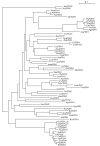NAD (+) -dependent Formate Dehydrogenase from Plants
- PMID: 22649703
- PMCID: PMC3347622
NAD (+) -dependent Formate Dehydrogenase from Plants
Abstract
NAD(+)-dependent formate dehydrogenase (FDH, EC 1.2.1.2) widely occurs in nature. FDH consists of two identical subunits and contains neither prosthetic groups nor metal ions. This type of FDH was found in different microorganisms (including pathogenic ones), such as bacteria, yeasts, fungi, and plants. As opposed to microbiological FDHs functioning in cytoplasm, plant FDHs localize in mitochondria. Formate dehydrogenase activity was first discovered as early as in 1921 in plant; however, until the past decade FDHs from plants had been considerably less studied than the enzymes from microorganisms. This review summarizes the recent results on studying the physiological role, properties, structure, and protein engineering of plant formate dehydrogenases.
Keywords: physiological role; plant formate dehydrogenase; properties; protein engineering; structure; expression;Escherichia coli.
Figures




References
-
- Rodionov Yu.V.. Uspekhi microbiologii. 1982;16:104–138.
-
- Ferry J.G.. FEMS Microbiol. Rev. 1990;7:377–382. - PubMed
-
- Vinals C., Depiereux E., Feytmans E.. Biochem. Biophys. Res. Commun. 1993;192:182–188. - PubMed
-
- Tishkov V.I., Galkin A.G., Egorov A.M.. Biochimie. 1989;71(4):551–557. - PubMed
-
- Tishkov V.I., Popov V.O.. Biochemistry (Mosc.) 69:1252–1267. - PubMed
LinkOut - more resources
Full Text Sources
Research Materials
Miscellaneous
